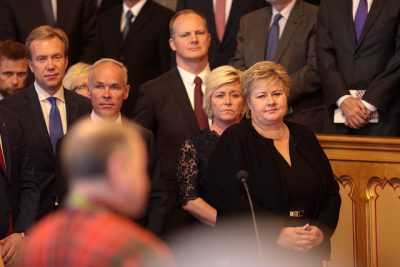NEWS ANALYSIS: Just as Prime Minister Erna Solberg was flying off to Beijing to normalize relations with China this past week, she was met with a torrent of bad political news at home. Now the question is whether her conservative coalition government will survive the September election and still be around to negotiate with the Chinese this fall on everything from free trade to human rights.

One poll, conducted by research firm Norstat for state broadcaster NRK, showed that Labour Party leader Jonas Gahr Støre is now preferred as Norwegian prime minister. Of those questioned, 44 percent think Støre is best-suited to take over as the country’s premier, while 38 percent still preferred Solberg. Another 18 percent weren’t sure.
Solberg’s own Conservative Party rose 1.3 points in another NRK poll, to command 23.7 percent of the vote, but her coalition and support partners lost more voter favour. The Progress Party fell 2.1 points, to just 12.3 percent of the vote, while the Liberal Party remained under the 4 percent level needed for representation in Parliament, to just 3.7 percent. The Liberals also performed poorly in another poll earlier this week, even though they had just held a relatively successful annual national meeting and received lots of media coverage.
The coalition’s other support party, the Christian Democrats, were steady at 5.1 percent of the vote but that didn’t give Solberg’s coalition the majority it will need to stay in power. Labour, meanwhile, rose slightly to 33.4 percent of the vote and its prospective coalition party, the Center Party, rose a bit as well, to 11.3 percent. Their former partner in the last left-center government, the Socialist Left (SV), also held on to 4.7 percent. With the left-leaning Greens claiming 2.6 percent, they’d have a clear majority.
Christian Democrats may defect
Then came news on Friday, just as Solberg was landing in Beijing, that a poll conducted for newspaper Aftenposten also left Solberg’s non-socialist coalition in the minority. More importantly, the Christian Democrats rose slightly to 5.7 percent of the vote, indicating they weren’t losing voters to the Center Party, which was steady at 11.5 percent. That left Aftenposten speculating that Labour, the Center Party and the Christian Democrats would have a clear majority alone even without the Socialist Left.
The Christian Democrats’ leader, Knut Arild Hareide, told Aftenposten that he still prefers to support or be part of a right-center government led by Solberg. If it can’t form a majority, however, “we’ll have to relate to that reality when we can’t have our first choice. We can’t close the door and throw away the key for all other possibilities than the Conservatives and the Liberals.” He noted that his party and the Center Party, for example, “share some of the same values” regarding district politics, support and protection for farmers and rural interests.
That seemed to indicate Solberg may lose the Christian Democrats as a support partner to the opposition. If neither her party nor the Progress Party and the Liberals generate a lot more voter support over the next five months, her government project will collapse.
Solberg’s ministries, meanwhile, were rolling out lots of details about their proposed reforms of agriculture and local governments just before she flew to China, along with a huge program for transportation improvements. They received mixed reactions and then came news that the government’s embrace of lower unemployment numbers may be misleading. Some economists worry that real unemployment in Norway is higher because some workers have dropped out of the workforce after giving up efforts to find new jobs. They may instead have opted to rely on savings, disability pay, very-early retirement or a spouse who can support them.
Researchers against them
Another poll released this past week gave Solberg perhaps the most cause for worry: Only 10 percent of researchers, those who often are held up as experts in their various fields, support the Conservatives and the Progress Party. If it was up to them, according to a poll conducted by members of the researchers’ national federation Forskerforbundet, Solberg’s government would be replaced by a solidly socialist coalition.
Only 1.1 percent of the researchers polled said they’d vote for the Progress Party. Another 9.1 percent favoured the Conservatives. Labour, however, won 34.6 percent of the vote, the Socialist Left 15.8 percent and the Reds (Norway’s communist party that currently has no representation in Parliament) would get 5.7 percent.
The Liberal Party, already struggling at present, should also be worried by the poll, according to professor and election researcher himself Frank Aarebrot of the Univeristy of Bergen. Only 7.5 percent of researchers polled said they’d vote for the Liberals, down from 11.4 percent at the last election in 2013. That indicates the Liberals have lost every third voter during the past four years.
“This is a group (the researchers) that could have become a core source of support for the Liberals,” Aarebrot said. “Such a large decline in support is a real danger signal for the party.” And for the Conservatives, who have relied on the Liberal and the Christian Democrats to give them a majority in Parliament. The Christian Democrats only attracted 2.7 percent of the researchers’ vote.
newsinenglish.no/Nina Berglund

